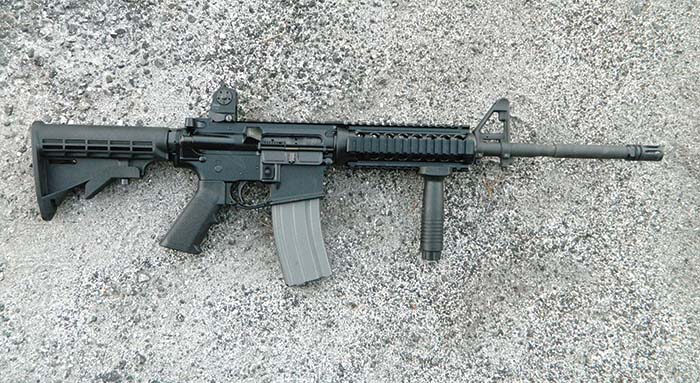The Daniel Defense rifle is a remarkably friendly design, with everything needed and nothing more. A real work horse.
By R.K. Campbell
When it comes to tactical gear – an overused term in today’s market – much of what is advertised as tactical doesn’t make the grade. I have lost count of the AR-15 type parts guns and gun show specials that I have seen cops attempt to deploy. The break in period to produce a reliable rifle from a disreputable beginning is often long and tortuous. This cuts deeply into both training time and the training budget. Armed professionals must realize that their life is riding on their gear. A rifle with gun show parts doesn’t always have the chrome lined barrel and chamber demanded for proper function. A failure to properly stake the bolt carrier keys is a common deficit among the parts guns. They may have a good name on the receiver but the internals are anyone’s guess. For confidence and superior function a good bet is the Daniel Defense rifle. The Daniel Defense rifle is a quality AR-15 rifle with good features. The company began to gain attention by securing government contracts by means of a difficult procurement process. They enjoy an excellent reputation.
Before we proceed let’s look at the tactical rifle. Professionals define the mission first; then choose the gear. Amateurs adopt a cheap solution and attempt to overreach their gear with unrealistic expectations. There are any number of incidents that have occurred that beg for officers and armed citizens to have a handy, powerful and accurate rifle on hand. These include the Texas Tower incident beginning in the 1960s and fast forwarding to take-over robberies by armed gangs as recently as yesterday.
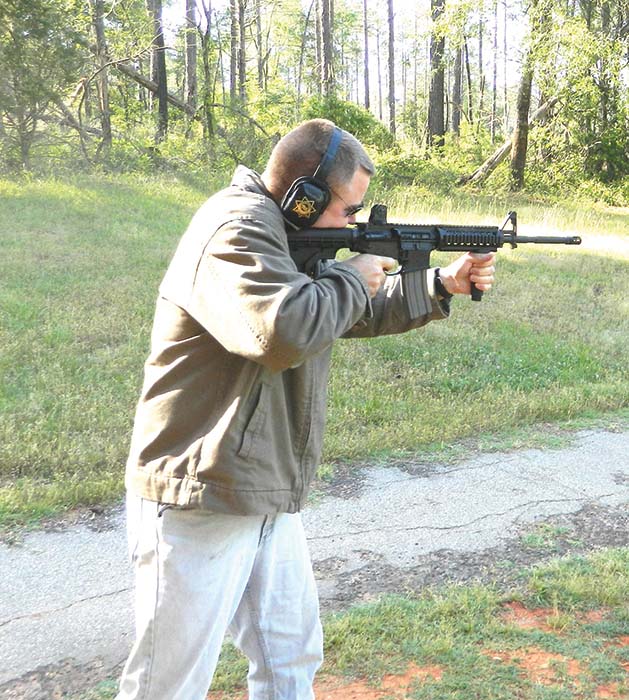
The rifle gives a qualified user an advantage over a person armed only with a handgun (provided the person wielding the rifle has fortitude and initiative). If the adversary is heavily armed, at least you have a level playing field. You may extend your will past handgun range and you may use the carbine much more efficiently at any range. The AR-15 rifle is the logical first choice, given the many rifles available, availability of support gear, and service history. There are rifles better than others but most of the bad rifles I have seen have been parts guns with poor quality parts and assembly. You pay your money and you take your choice. But there are defining characteristics of a rifle that is intended for general patrol and defense use.
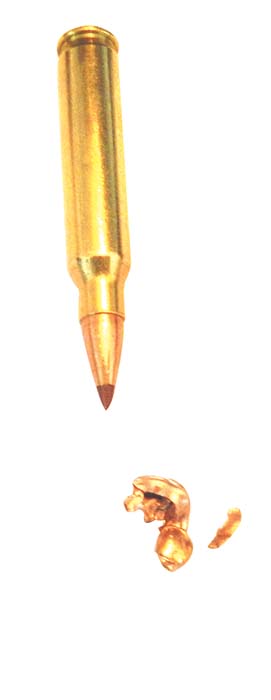
The .223 can be frangible at close range, offering excellent wound ballistics.
The rifle should be chambered for the 5.56mm/.223 Remington cartridge. (I know there is a qualified difference in the two calibers – Black Hills, Hornady and Winchester supply the ammunition I use in my AR-15 rifle and they know what they are doing.) Discussions of wound ballistics can get complicated, ugly and even psychotic quickly. The .223 offers excellent wound ballistics to 125 yards, give or take, depending upon the exact load and the barrel length of the rifle used. The cartridge generates sufficient velocity to insure that the bullet expands violently at modest ranges. This all but insures the bullet stays in the felon’s body in a crowded urban environment. In rural areas the advantage remains. A minimum of well directed rounds will achieve the incapacitation of the threat. The cartridge is very accurate in quality rifles and the high velocity and frangibility of the bullet limits over penetration and ricochet. Once the range is extended past 100 yards, upset and bullet fragmentation is less likely, but this is extraordinary range for civil use. With the proper load such as Black Hills Ammunition 77 grain open tip loads the .223 may be effective to 200 yards, but this is the exception to the rule. Most engagement ranges are short. The rifle should be light enough for constant carry during a stalk of felons in the open, in the woods, or in an urban environment and be short enough for deployment inside buildings. Magazines, slings and support gear should be readily available. The rifle should be equipped with a ghost ring sight that allows rapid engagement of targets at typical encounter ranges but allows accurate shooting with an accuracy standard no less than two MOA at one hundred yards. The rifle must be reliable in action with a minimum of maintenance.
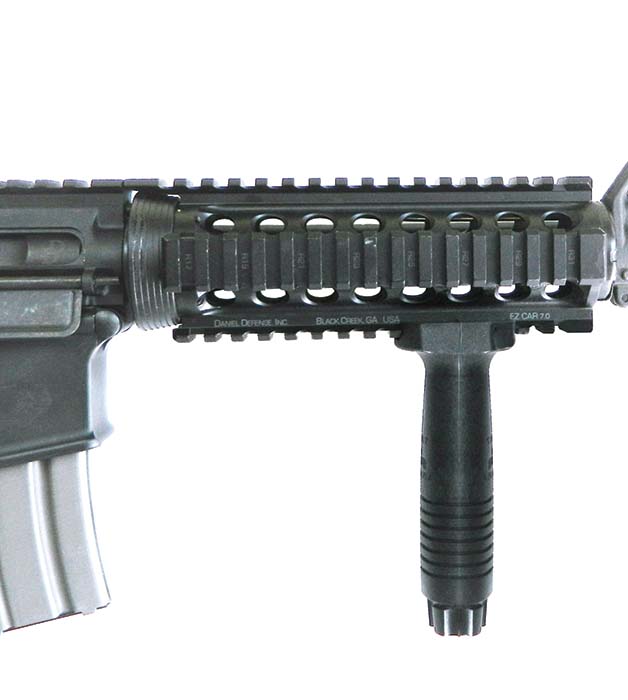
The Daniel Defense rifle is a logical development from a company that has secured military contracts for parts consisting of upgrades for the AR-15 including the forend/rail system. The Daniel Defense rifle is a standard design AR-15 with gas impingement system and all of the AR-15 type controls including the ergonomically designed magazine release and safety. The advanced trademark forend is evident in the design. The Daniel Defense rifle is the modern flat top type with provisions for mounting an optical sight if desired. The rifle is supplied with efficient iron sights from the factory. These battle sights are well designed with excellent utility both for rapid acquisition of the target and for precision fire to 100 yards or more. The archetypical flash suppressor is present. A Blue Force Vickers sling was fitted to the Daniel Defense rifle during the evaluation. This is a well designed sling that offers good comfort and if need be an additional rest when steadying the rifle for off hand fire. The rifle slung easily when walking to the target stand at a long 100 yards. I recommend this sling as a step above the rest.
Length of pull can be important during different tactical applications including when wearing body armor or firing from behind cover. The Daniel Defense stock features three positions for adjustment. The engagements are positive and the stock rugged enough for duty use. The bore is chrome lined with a twist of 1 turn in 7 inches. The bolt was removed and examined; the carrier key is properly staked. Staking the carrier key is an elementary procedure that some makers seem to find to be too much trouble. I leave any rifle without the carrier key properly staked on the shelf and so should you. (If you own such a rifle have the carrier key staked properly sooner rather than later.) The two halves of the receiver fit tightly. Trigger compression is typical AR-15, breaking at 4.5 pounds. The rifle is supplied with a single thirty-round magazine. I supplemented the issued magazine with a set of Brownells AR- 15 magazines. These magazines have given yeoman service and continue to serve in the majority of my AR-15 rifles. Additionally, HK magazines are first class in every way, well worth their price. Good magazines take the worry out of being close.
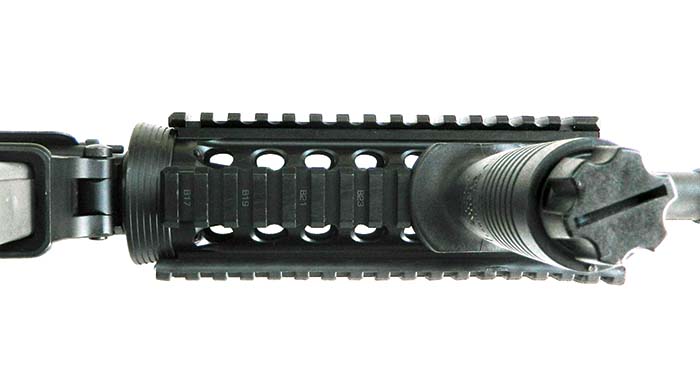
Shooting
During the evaluation an X bipod from Montie Design was used. The three legged X bipod quickly pins together into a triangular rest yet folds easily for storage. This device is handy, light enough at 12.1 ounces, and offers an excellent steadying device for long range shooting. During the course of the test and evaluation well over 1,000 rounds of ammunition were fired in this rifle including 280 as quickly as we could load magazines – leaving the forend smoking. There were no failures to feed, chamber, fire or eject. The rifle was not cleaned for the first 500 rounds, but began the test well lubricated. We squirted lubrication in the bolt every few hundred rounds. Not ideal maintenance but a test of a hard use rifle. The handling of the rifle cannot be faulted. The rifle comes on target quickly and the sight and trigger combination make for excellent practical accuracy. During the evaluation the majority of rounds fired were Black Hills 55 grain blue box remanufactured loads; although we also fired a good amount of whatever was available including 55, 60 and 62 grain weight bullets. Additionally, several magazines of handloads that were recently put up on Redding dies were also used. The results were good on all counts. This rifle is more accurate than most anyone can hold in off hand fire. There is no discernible difference in off hand fire between these inexpensive practice loads and premium tactical loads. It is all about sight picture, sight alignment and trigger compression. When firing from the barricade or solid bench rest differences in accuracy were more apparent.
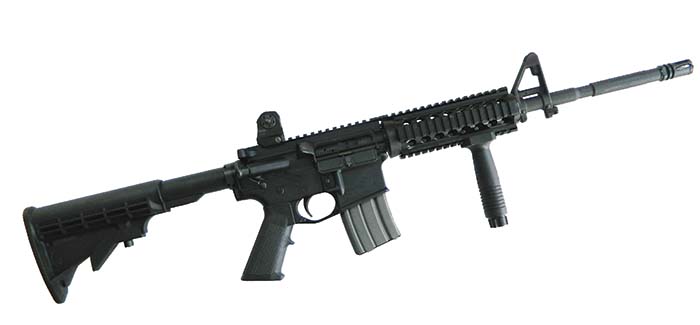
There is nothing wrong with the 55 grain FMJ load for all around use at moderate range. This loading breaks up on impact in the body given sufficient velocity and has a good reputation. Public safety and greater efficiency call for different choices. My rule is to practice with the remanufactured or generic loads and deploy the finest loads I am able to obtain. The Daniel Defense rifle digested the various tactical loads from 55, 60, 69 and 77 grain weights with good function and accuracy. It should be noted that the 40 grain varmint or blitz loads seem to have less momentum and one should not trust their reliable function in a less than perfectly maintained rifle. Penetration is limited with the 40 grain load which is useful in running coyotes away from the chickens but not in personal defense. I qualified function and practical accuracy with favored loads including the Black Hills 60 gr. JSP, the Black Hills 40 gr. A Max, the 60 grain A Max loading, the Black Hills 77 grain Open Tip, the Cor Bon 55 gr. JSP, Cor Bon DPX, Cor Bon 69 grain Match, the Hornady 60 grain TAP , the HSM 60 grain A Max and the Winchester 69 grain JSP. All proved accurate and reliable. A trained operator that understands catching the link during trigger reset, controlling the trigger and sights, is able to command the ground in front of the muzzle of the AR-15. Every rifle (or any firearm) has a certain reset. Rather than moving the finger from the trigger during reset a trained operator will keep his finger on the trigger and ride the reset.
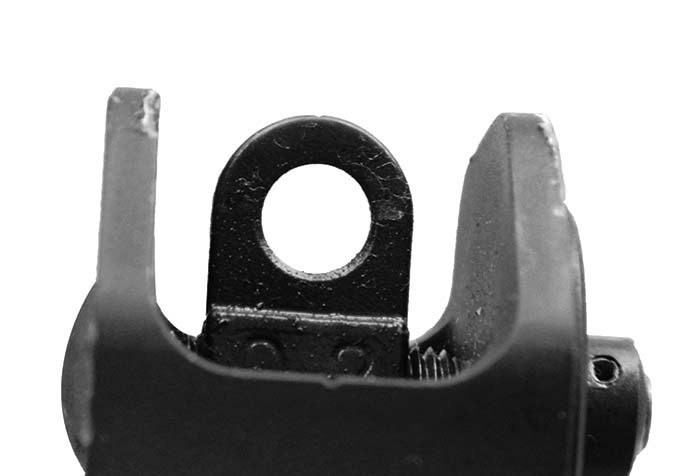
The final choice in ammunition demands careful consideration from those who use the rifle. Two basic themes have emerged in .223 rifle loads for serious use. This is to increase wound ballistics with a frangible bullet and the other is to increase penetration for special purposes by use of a heavier bullet. Among the single most successful loads is the Black Hills 77 grain Open Tip. Proven in war time use this load not only offers good wound ballistics but gilt edged accuracy. Another contender is the Winchester 69 grain JSP. The 69 grain JSP expands and stays together like a .30 bullet. An interesting combination comes from HSM, a respected shop that produces custom loaded law enforcement loadings. They have developed a loading that gives excellent barrier penetration with the .223. This restricted design increases tactical and barrier penetration for specific uses. I found this loading accurate and in limited testing of tactical barriers, effective. The HSM load also showed good accuracy.
Naturally we wished to evaluate the rifle at long range. The battle sight offers good utility once learned and in trained hands. At first the front sight may seem wide for long range shooting but it depends upon the target. We do not wish to hazard short range speed by use of a smaller front blade. The front sight completely covers the 12 inch plate at 300 yards. Do the math; you have a challenge that limits shooters to a hit ratio of about fifty per cent. At 200 yards we were on the money at about eighty per cent on the twelve inch gong using the sling without a time limit, and at ninety per cent or better when going prone and using the bipod. If you anticipate firing the rifle often at long range then an optical sight is needed. Most of us will not have that need, and the rifle remains a great problem solver at moderate range. With the inherent accuracy of the type and the great handling and reliability of the Daniel Defense rifle this AR-15 is useful over a broader spectrum than most firearms.
The Daniel Defense rifle is true to the original AR-15 concept of a short, light rifle with plenty of power but light recoil and excellent hit probability. We fired the rifle extensively and did not break it under controlled conditions. A fighting man should not have a favorite weapon but work with what he has. But if you have a choice this is a rifle well worth its price. The Daniel Defense rifle is accurate enough for any mission and offers quality of material and production. That is all we can ask.
One hundred yard groups – three shot groups from a solid bench rest using Bushnell First Strike Red Dot.
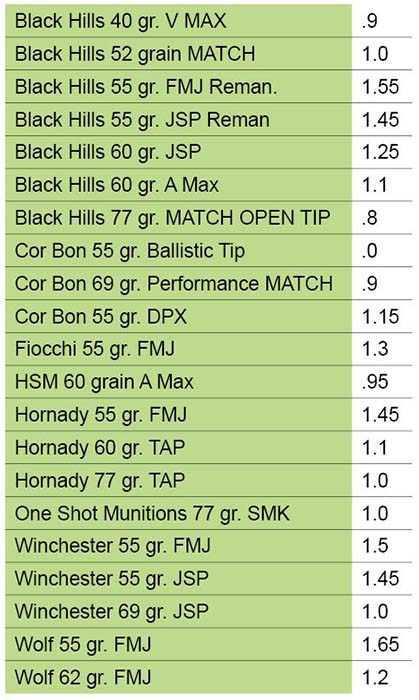
| This article first appeared in Small Arms Review V19N2 (March 2015) |



